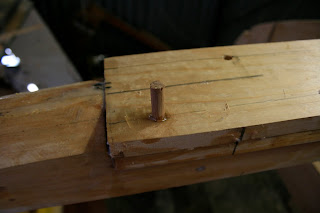I am actually learning quite well how to adapt what is on the plans to what is actually in front of me, which is very nice. It seems that so far my basic skills at eating chips are enough! Lovely.
My lovely partner staked the cost of a thicknesser for me for a fortnight or two so I could dress my timber at home (I love her more and more and more and she has to get a mention here or I may have a boat but no bed to sleep on in my forthcoming future. She is also very pretty. And usually right about me needing to do dishes. And buy flowers. SMIIIIILE?). Needless to say this is amazing and incredibly useful. I thicknessed and cut the timber for the keelson and laid the timbers with little trouble, except for some mis-timing with epoxy that caused a bit of a rush at the end. But you live, you learn.
I've decided to omit metal fastenings as much as possible in the build, as according to most home-building advocates and intellects they are more trouble than they're worth in the long run, and simply using epoxy and wood alone is enough, if treated right. So, in the spirit of trusting the opinions of others whilst having very little idea about what I'm doing, I used temporary screws to fasten the two keelson layers, laminated with epoxy, to the frames. This holds them together during lamination and holds them to the frame. It worked well, which is nice, though I'm still learning how much epoxy is the right amount for certain jobs. Afterwards, you need to re,pve tje screws, bore the holes out wide and plug them, usually with wooden dowels. This means you can easily plane or shape the surface, and there are no voids for air or other nonsense to hang out and basically be delinquent and troublesome.
 Afterwards, you soak out the holes with unthickened epoxy, and plug em with dowels, making sure there's enough epoxy to ensure an airtight and filled join.
Afterwards, you soak out the holes with unthickened epoxy, and plug em with dowels, making sure there's enough epoxy to ensure an airtight and filled join.
A close-up of the dowel plug (cut over-size and to be cut down like a tall poppy and sanded smooth when it's dry)


My little porcupine boat.
So next, I cut these down to size, and then do the exact same job to the chines and gunwales. Then stringers. Then bevelling the keelson, chines and stringers. Then I can plank my lady. Speaking of which, my lady might need a good thankyou planking. So, until I do more work,
Adieu.

No comments:
Post a Comment